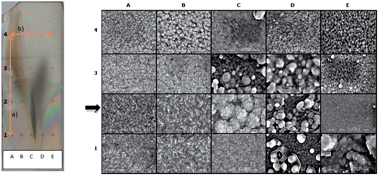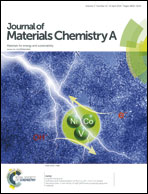Combinatorial aerosol assisted chemical vapour deposition of a photocatalytic mixed SnO2/TiO2 thin film†
Abstract
Combinatorial Aerosol Assisted Chemical Vapour Deposition (cAACVD) was used to grow a thin film that graduated across its width from tin dioxide to titanium dioxide. This is a relatively new technique that can be used to create a variety of mixed phase and composition thin films on a single substrate. Here cAACVD was used to deposit a mixed phase TiO2 and SnO2 film and composition was related to UV photocatalysis, hydrophobicity and microstructure not inherent to anatase TiO2 or cassiterite SnO2. Characterisation was achieved using X-ray diffraction (XRD), X-ray photoelectron spectroscopy (XPS), scanning electron microscopy (SEM), energy dispersive X-ray spectroscopy (EDX) and UV-Vis spectroscopy. Functional testing to elucidate the differences in functional properties across the film was undertaken by the photo-induced degradation of a resazurin ‘intelligent’ ink, a photo-induced wettability study and two-point resistivity measurements. Functional properties showed enhanced photocatalysis in comparison to Pilkington Activ™ with similar formal quantum yield (molecules destroyed per absorbed photon) and formal quantum efficiency (molecules destroyed per incident photon) values.


 Please wait while we load your content...
Please wait while we load your content...